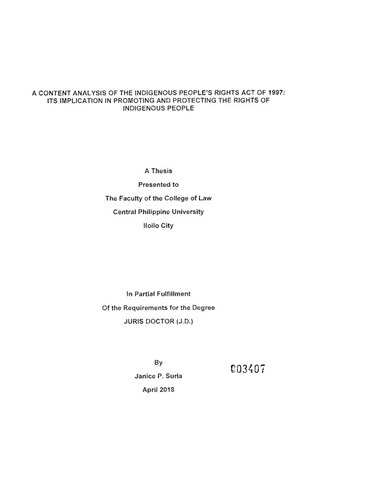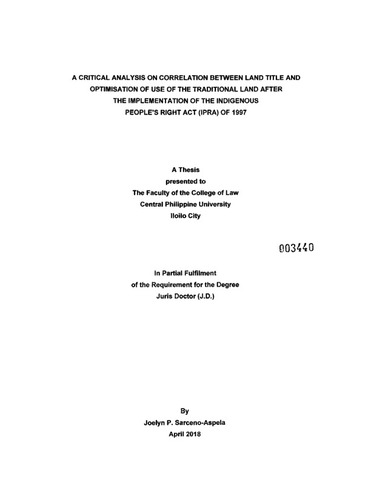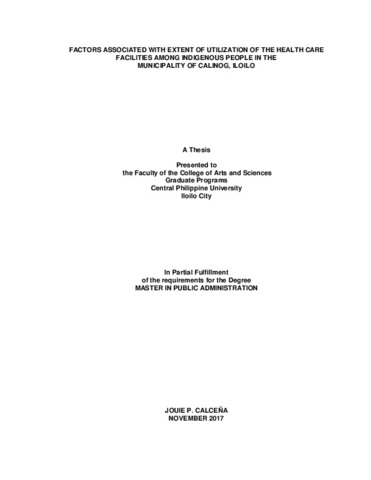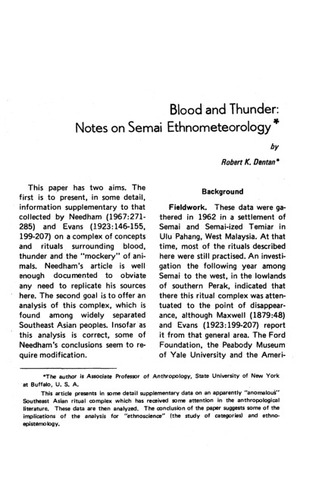A content analysis of the Indigenous People’s Rights Act of 1997: Its implication in promoting and protecting the rights of indigenous people
| dc.contributor.adviser | Alibogha, Salex E. | |
| dc.contributor.author | Suria, Janice P. | |
| dc.date.accessioned | 2021-06-29T06:04:11Z | |
| dc.date.available | 2021-06-29T06:04:11Z | |
| dc.date.issued | 2018 | |
| dc.identifier.citation | Suria, J. P. (2018). A content analysis of the Indigenous People’s Rights Act of 1997: Its implication in promoting and protecting the rights of indigenous people (Unpublished postgraduate thesis). Central Philippine University, Jaro, Iloilo City. | en_US |
| dc.identifier.uri | https://hdl.handle.net/20.500.12852/1117 | |
| dc.description | Abstract only | en_US |
| dc.description.abstract | This study was primarily conducted to analyze the content of The Indigenous People’s Right Act of 1997 (IPRA) to determine its implication in promoting and protecting the rights of indigenous people. It was conducted within School Year 2016-2017. It focused on the discussion of five important features of IPRA such as the right to ancestral domains among others, its ambiguous provisions, and its proposed amendments. This qualitative research employed content analysis research design through examining and interpreting the carefully selected provisions of the law. No specific key informants were obtained. Data gathered was based on thorough research of related literature and studies affecting the rights of indigenous people via books and online articles as fast and accurate sources of information with the application of IPRA. Analysis and conclusions were drawn with the help of gathered information about IPRA, IP. their statuses as well as issues concerning IPs rights. The findings and analysis were presented according to the objectives of the study. Some points found out were: The rights granted to the ICCs/IPs over the natural resources in their ancestral domains merely gives them the right to the small-scale utilization of these resources and a priority in their large-scale development and exploitation. The researcher found nine ambiguous provisions in the law. One of the proposed amendments to IPRA is a deletion of the term “natural resources” in the phrase “right to develop lands and natural resources” because natural resources are properties of the State as supported by the Regalian Doctrine. | en_US |
| dc.format.extent | viii, 103 leaves | en_US |
| dc.language.iso | en | en_US |
| dc.rights | Attribution-NonCommercial-NoDerivs 3.0 Philippines | * |
| dc.rights.uri | http://creativecommons.org/licenses/by-nc-nd/3.0/ph/ | * |
| dc.subject.ddc | Law Library 340.72 Su77 2018 | en_US |
| dc.subject.lcsh | Indigenous peoples | en_US |
| dc.subject.lcsh | Indigenous peoples--Legal status, laws, etc. | en_US |
| dc.subject.lcsh | Indigenous peoples--Civil rights | en_US |
| dc.subject.lcsh | Human rights | en_US |
| dc.subject.lcsh | Indigenous peoples--Land tenure | en_US |
| dc.title | A content analysis of the Indigenous People’s Rights Act of 1997: Its implication in promoting and protecting the rights of indigenous people | en_US |
| dc.type | Thesis | en_US |
| dc.description.bibliographicalreferences | Includes bibliographical references | en_US |
| dc.contributor.chair | Bedona, Zacarias D. Jr. | |
| dc.contributor.department | College of Law | en_US |
| dc.description.degree | Juris Doctor | en_US |
| local.subject | Indigenous People’s Right Act of 1997 (IPRA) | en_US |
| local.subject | RA 8371 | en_US |
Fichier(s) constituant ce document
Ce document figure dans la(les) collection(s) suivante(s)
-
Juris Doctor [144]






